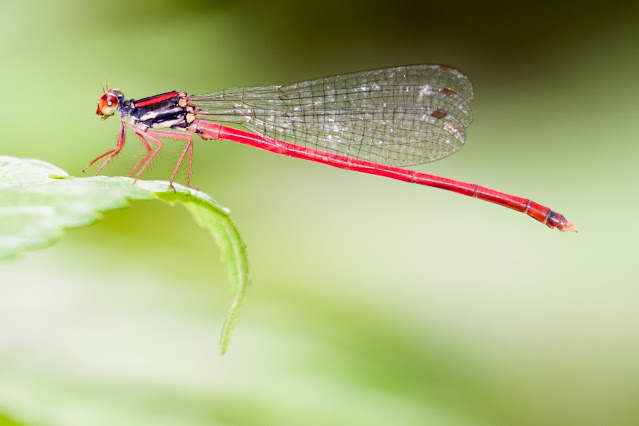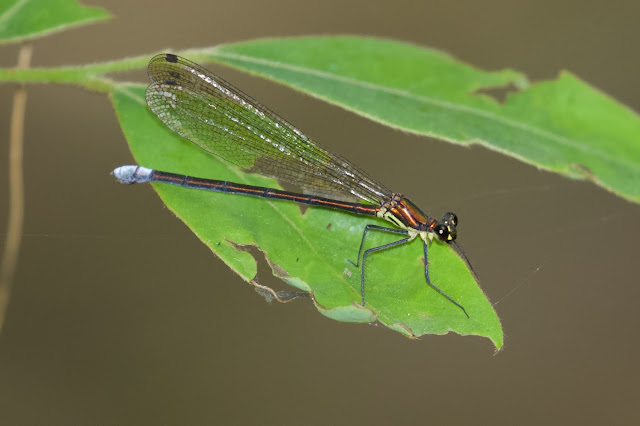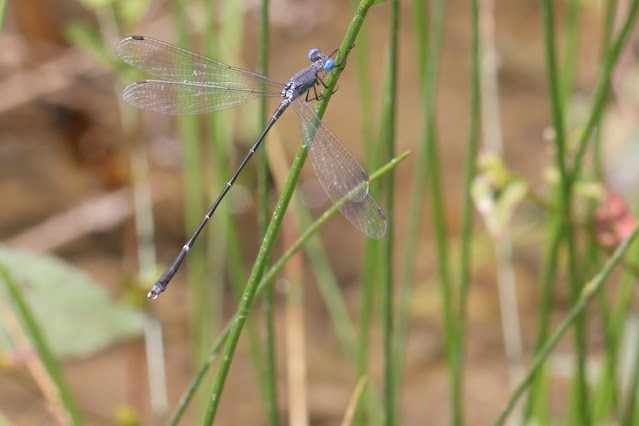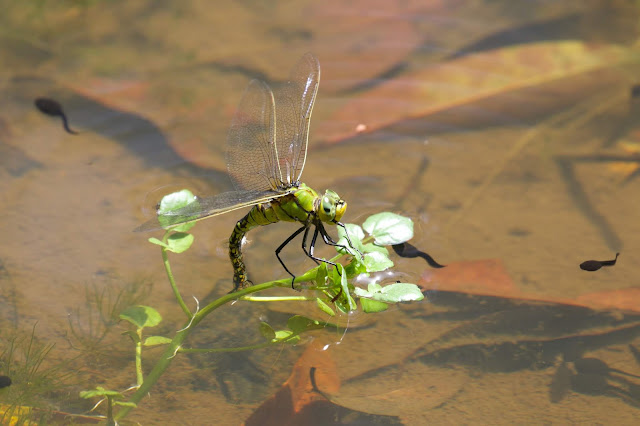Nepal Odonata Checklist
 |
| Calicnemia doonensis carminea |
As more young scientists and enthusiasts become interested in Odonata in Nepal the number of sightings and new records will probably continue to increase. The first complete checklist was made thirty-one years ago by G. Vick. A new regional, six-country, checklist for 2020 is complete. This will be very helpful in determining species in the surrounding countries as well as in Nepal.
Color codes: species in orange are found in this blog; blue is for endemic; red? is for a questionable record. Within the blog is information on the elevation and habitat of the recorded species.
Order Odonata Fabricius, 1793
Suborder Zygoptera
Family Synlestidae Tillyard, 1917
Megalestes irma (Fraser, 1926)
Megalestes major Selys, 1926
Family Lestidae Calvert, 1907
Indolestes `
Indolestes cyaneus (Selys, 1962)
Lestes
Lestes dorothea Fraser, 1924
Lestes praemorsus decipiens Kirby, 1893
Family Platystictidae Kennedy, 1920
Drepanosticta
Drepanosticta carmichaeli (Laidlaw 1915)
Family Calopterygidae Selys, 1850
Caliphaea
Caliphaea confusa Hagen in Selys, 1853
Neurobasis
Neurobasis chinensis (Linneaus, 1758)
Vestalis
Vestalis gracilis (Rambur, 1842)
Family Chlorocyphidae Cowley 1937
Aristocypha
Aristocypha cuneata (Selys, 1853)
Aristocypha quadrimaculata Selys, 1853
Aristocypha trifasciata Selys, 1853
Heliocypha
Heliocypha biforata (Selys, 1859)
Libellago
Libellago lineata (Burmeister, 1839)
Rhinocypha
Rhinocypha unimaculata (Selys, 1853)
Family Euphaeidae Yakobson & Bianchi, 1905
Anisopleura
Anisopleura comes Hagen, 1880
Anisopleura lestoides Selys, 1953
Anisopleura subplatystyla Fraser, 1927
Bayadera
Bayadera hyalina Selys, 1879
Bayadera indica (Selys, 1853)
Bayadera longicauda Fraser, 1928
Euphaea
Euphaea ochracea Selys, 1859
Family Philogangidae Kennedy, 1920
Philoganga Montana Hagen in Selys, 1859
Family Platycnemididae Yakobson & Bainchi, 1905
Calicnemia
Calicnemia doonensis carminea* Lieftinck, 1984
Calicnemia eximia (Selys, 1863)
Calicnemia miniata (Selys, 1886)
Calicnemia mortoni Laidlaw, 1917
Calicnemia nipalica Kimmins, 1958
Calicnemia pulverulans (Selys, 1886)
Coeliccia
Coeliccia renifera (Selys, 1886)
Copera
Copera marginipes (Rambur, 1842)
Copera vittata Selys, 1863
Onychargia
Onychargia atrocyana (Selys, 1865)
Prodasineura
Prodasineura autumnalis (Fraser, 1922)
Prodasineura odoneli (Fraser, 1922)
Family Coenagrionidae Kirby, 1890
Aciagrion
Aciagrion approximans approximans (Selys, 1876)
Aciagrion hisopa? (Selys, 1876)
Aciagrion olympicum Laidlaw, 1919
Aciagrion pallidum Selys 1891
Agriocnemis
Agriocnemis clauseni Fraser, 1922
Agriocnemis femina (Brauer, 1868)
Agriocnemis lacteola Selys, 1877
Agriocnemis pygmaea (Rambur, 1842)
Amphiallagma
Amphiallagma parvum (Selys, 1877)
Ceriagrion
Ceriagrion azureum (Selys, 1891)
Ceriagrion cerinorubellum (Brauer, 1865)
Ceriagrion coromandelianum (Fabricius, 1798)
Ceriagrion fallax Ris, 1914
Ceriagrion olivaceum olivaceum Laidlaw, 1914
Coenagrion
Coenagrion exclamationis Fraser, 1919
Ischnura
Ischnura elegans (Vander Linden, 1823)
Ischnura foricpata Morton, 1907
Ischnura nursei Morton, 1907
Ischnura rubilio Selys, 1876
Ischnura rufostigma Selys, 1876
Paracercion
Paracercion calamorum Ris, 1916
Paracercion malayanum (Selys, 1876)
Pseudagrion
Pseudagrion australasiae Selys, 1876
Pseudagrion decorum (Rambur, 1842)
Pseudagrion microcephalum (Rambur, 1842)
Pseudagrion rubriceps rubriceps Selys, 1876
Pseudagrion spencei Fraser, 1922
Suborder Anisozygoptera Hanlirsch 1906
Family Epiophlebia Muttkowshi, 1910
Epiophlebia laidlawi Tillyard, 1921
 |
| Microgomphus phewataali |
Suborder Anisoptera
Family Aeshnidae Leach, 1815
Aeshna
Aeshna petalura Martin, 1906
Anaciaeschna
Anaciaeschna martini (Selys, 1897)
Anaciaeschna jaspidea (Burmeister, 1839)
Anax
Anax guttatus (Burmeister, 1839)
Anax immaculafrons Rambur, 1842
Anax indicus
Anax nigrofasciatus Fraser, 1935
Anax parthenope (Selys, 1839)
Cephalaeschna
Cephalaeschna acutifrons (Martin, 1909)
Cephalaeschna klapperichi Schmidt, 1961
Cephalaeschna masoni (Martin, 1909)
Cephalaeschna obifrons Selys, 1883
Cephalaeschna virdifrons (Fraser, 1922)
Gynacantha
Gynacantha bayadera Selys, 1891
Gynacantha khasiaca (MacLachlan, 1896)
Gynacantha incisura Fraser, 1935
Gynacantha subinterrupta Rambur, 1842
Gynacanthaeschna
Gynacanthaeschna sikkima (Karsch, 1891)
Periaeschna
Periaeschna unifasciata Fraser, 1935
Indaeschna
Indaeschna erythromelas (MacLachlan, 1896)
Sarasaeschna
Sarasaeschna martini (Laidlaw, 1921)
Sarasaeschna sp. nov.1 Godavari Location
Sarasaeschan sp. nov.2 Daman Location
Family Gomphidae Rambur, 1842
Anisogomphus
Anisogomphus bivittatus Selys, 1854
Anisogomphus occipitalis (Selys, 1854)
Anisogomphus orites Laidlaw, 1922
Burmagomphus
Burmagomphus hasimaricus Fraser 1926
Burmagomphus sp. nov.
Davidius
Davidius aberrans aberrans (Selys, 1873)
Davidius delineatus Fraser, 1926
Gomphidia
Gomphidia t-nigrium Selys, 1854
Ictinogomphus
Ictinogomphus angulosus ? (Selys, 1854)
Ictinogomphus kishori Ram, 1985
Ictinogomphus pertinax (Selys, 1854)
Ictiniogomphus rapax (Rambur, 1842)
Macrogomphus
Macrogomphus montanus Selys, 1869
Macrogomphus robustus Selys, 1854
Macrogomphus seductus Fraser, 1926
Microgomphus
Microgomphus phewataali* Conniff & Limbu 2018
Nepogomphus
Nepogomphus modestus (Selys, 1878)
Lamelligomphus
Lamelligomphus biforceps (Selys, 1878)
Lamelligomphus risi Fraser, 1922
Onychogomphus
Onychogomphus cerastis (Selys, 1854)
Nychogomphus
Nychogomphus duaricus (Fraser, 1924)
Nychogompus saundersii (Selys, 1854)
Scalmogomphus
Scalmogomphus bistrigatus (Hagen in Selys, 1854)
Scalmogomphus schmidti Fraser, 1937
Paragomphus
Paragomphus lindgreni (Fraser, 1923)
Paragomphus lineatus (Selys, 1850)
Parissogomphus
Parissogomphus stevensi Laidlaw, 1922
Platygomphus
Platygomphus dolabratus Selys, 1854
Stylogomphus
Stylogomphus inglisi Fraser, 1922
Family Chlorogomphidae Needham, 1903
Chlorogomphus mortoni Fraser, 1923
Chlorogomphus preciosus preciosus (Fraser, 1924)
Chloropetalia
Chloropetalia selysi Fraser, 1929
Watanabeopetalia
Watanabeopetalia atkinsoni (Selys, 1878)
Family Cordulegasteridae Hagen, 1875
Anotogaster
Anotogaster basilis palampurensis Fraser, 1929
Anotogaster gregoryi Fraser, 1924
Anotogaster nipalensis Selys, 1854
Corulegaster
Corulegaster brevistigma (Selys, 1854)
Neallogaster
Neallogaster hermoinae (Fraser, 1927)
Neallogaster latifrons (Selys, 1878)
Neallogaster ornata (Asahina, 1982)
Family Macromiidae Needham, 1903
Epophthalmia
Epophthalmia frontalis Selys, 1871
Macromia
Macromia cingulata Rambur, 1842
Macromia flavorcolorata Fraser, 1922
Macromia moorei Selys, 1874
Macromia sombui * Vick, 1988
Family Corduliidae Selys, 1850
Somatochlora
Somatochlora daviesi Leiftinck, 1977
Family Libellulidae Leach, 1815
Acisoma
Acisoma panorpoides Rambur, 1842
Aethriamanta
Aethriamanta brevipennis (Rambur, 1842)
Brachydiplax
Brachydiplax chalybea Brauer, 1868
Brachydiplax sobrina (Rambur, 1842)
Brachythemis
Brachythemis contaminata (Fabricius, 1793)
Cratilla
Cratilla lineata caliverti Förster, 1903
Cratilla metalica (Brauer, 1878)
Crocothemis
Crocothemis erythraea (Brullé, 1832)
Crocothemis servilia (Drury, 1770)
Diplacodes
Diplacodes lefebvrii (Rambur, 1842)
Diplacodes nebulosa (Fabricius, 1793)
Diplacodes trivialis (Rambur, 1842)
Libellula
Libellula quadrimaculata Linneaus, 1758
Lyriothemis
Lyriothemis bivittata (Rambur, 1842)
Nannoypha
Nannoypha pygmaea (Rambur, 1842)
Neurothemis
Neurothemis fulvia (Drury, 1773)
Neurothemis intermedia (Rambur, 1842)
Neurothemis tulia (Drury, 1773)
Onychothemis
Onychothemis testacea Laidlaw, 1902
Orthetrum
Orthetrum glaucum (Brauer, 1865)
Orthetrum internum MacLaghlan, 1894
Orthetrum luzonicum (Brauer, 1868)
Orthetrum pruinosum neglectum (Rambur, 1842)
Orthetrum sabina sabina (Drury, 1770)
Orthetrum triangulare triangulare (Selys, 1878)
Palpopleura
Palpopleura sexmaculata (Fabricius, 1787)
Pantala
Pantala flavescens (Fabricius, 1798)
Potamarcha
Potamarcha congener (Rambur, 1842)
Pseudotramea
Pseudotramea prateri Fraser, 1920
Rhodothemis
Rhodothemis rufa (Rambur, 1842)
Rhyothemis
Rhyothemis plutonia Selys, 1883
Rhyothemis triangularis Kirby, 1889
Rhyothemis variegata variegata (Linnaeus, 1763)
Selysiothemis
Selysiothemis nigra (Vander Linden, 1825)
Sympetrum
Sympetrum fonscolombii (Selys, 1840)
Sympetrum haritonovi Borisov, 1983
Sympetrum hypomelas (Selys, 1884)
Sympetrum oriental (Selys, 1883)
Sympetrum speciosum Oguma, 1915
Sympetrum striolatum commixtum (Selys, 1884)
Tetrathemis
Tetrathemis platyptera Selys, 1878
Tholymis
Tholymis tillarga (Fabricius, 1798)
Tramea
Tramea basilaris (Palisot de Beauvois, 1805)
Tramea limbata (Desjardins, 1832)
Tramea virginia (Rambur, 1842)
Trithemis
Trithemis aurora (Burmeister, 1839)
Trithemis festiva (Rambur, 1842)
Trithemis pallidinervis (Kirby, 1889)
Urothemis
Urothemis signata signata (Rambur, 1842)
Zygonyx
Zygonyx iris (Selys, 1869)
Uncertain designation
Idyonyx stevensi Fraser, 1924
 |
| Anotogaster nipalensis + exuvia |




























.jpeg)

.jpeg)
































































































































